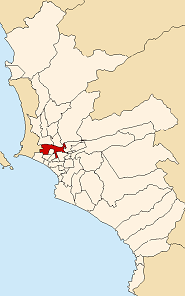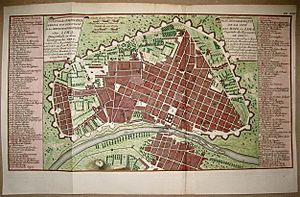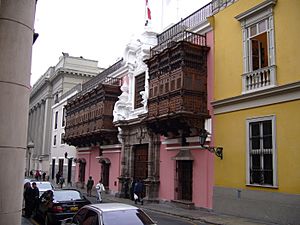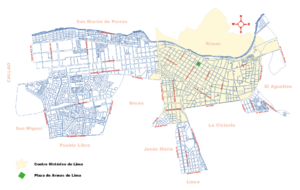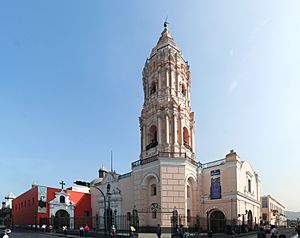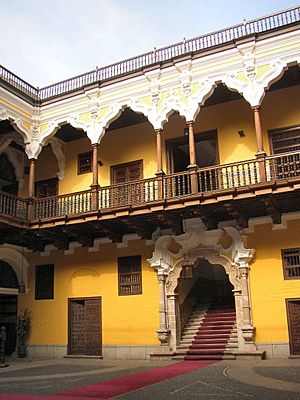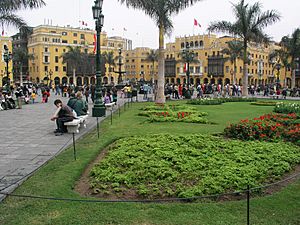Historic Centre of Lima facts for kids
| UNESCO World Heritage Site | |
|---|---|
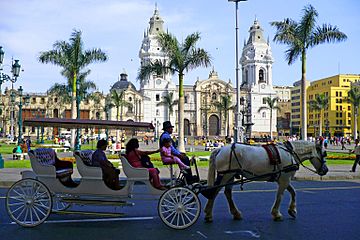
The Cathedral of Lima located in the main square of the historic center
|
|
| Location | Lima, Peru |
| Criteria | Cultural: (iv) |
| Inscription | 1988 (12th Session) |
| Extensions | 1991 |
| Area | 259.36 ha (640.9 acres) |
| Buffer zone | 766.7 ha (1,895 acres) |
The Historic Centre of Lima is a very important and beautiful part of Lima, the capital city of Peru. It's located mainly in the city center, also known as Cercado de Lima, and the Rímac areas. This historic area is one of the most popular places for tourists to visit in Peru.
Contents
- Founding of Lima
- Beautiful Balconies of Lima
- Grand Colonial Life
- Important Buildings and Places
- Archbishop's Palace
- Museum of Italian Art
- House of Aliaga
- House of Oidor
- House of Pilatos
- Goyeneche House
- Riva Agüero House
- Cathedral Basilica of Lima
- Basilica and Convent of Santo Domingo
- Basilica and Convent of San Francisco
- Basilica La Merced
- Sanctuary and Monastery of Las Nazarenas
- Basilica of San Pedro
- Government Palace
- Torre Tagle Palace
- University Park and "Casona" of San Marcos University
- Plaza Mayor (Main Square)
- Plaza San Martín
- Plaza Dos de Mayo
- Court of Santo Oficio
- See also
Founding of Lima
The city of Lima was started by Francisco Pizarro on January 18, 1535. He first named it "City of the Kings." But over time, people kept using its original name, Lima.
The name "Lima" might come from two different old languages. In the Aymara language, "lima-limaq" means "yellow flower." In the Quechuan language, "rimaq" means "talker." The river that flows through the city, the Rímac River, also gets its name from this same Quechuan word.
In 1988, UNESCO recognized the historic center of Lima as a World Heritage Site. This means it's a very special place that needs to be protected. It was chosen because of its unique style and many old buildings from when Spain ruled Peru.
Beautiful Balconies of Lima
The historic center of Lima has more than 1,600 balconies! These balconies were built a long time ago, both during the time of the Viceroyalty of Peru (when Spain ruled) and later when Peru became a republic.
To help keep these balconies looking new, the city of Lima has a special program. People and companies can "adopt" a balcony and help pay for its care. All these beautiful balconies make this part of the city look very special and unique.
Grand Colonial Life
During the time of the Viceroyalty of Peru, Lima was a place of great art and luxury. Life there was very grand and royal.
The viceroy was like a representative of the Spanish king in Peru. Being chosen as viceroy was a huge honor and showed that someone was very successful in the colonial government.
When new viceroys arrived in Lima, their entrances were incredibly fancy. Sometimes, the streets from the city gates all the way to the Viceroy's Palace were even paved with silver bars! This showed just how rich and powerful the city was.
Important Buildings and Places
Archbishop's Palace
The Archbishop's Palace is where the main religious leader of Lima, the Archbishop of Lima, lives. It's a popular place for tourists to visit in the Historical centre of Lima.
The first big church here started being built in 1535. In 1541, the Pope made it an important church center. By 1547, Lima became an archdiocese, which for a short time, was the largest church area in the world. Saint Rosa of Lima is the special patron saint of this church center.
Museum of Italian Art
The Museum of Italian Art is the only museum in Peru focused on European art. It has a large collection of paintings, sculptures, drawings, and ceramics. These artworks were created by Italian artists in the early 1900s. The museum also has 35 modern Italian paintings.
House of Aliaga
This house was built in 1535, the same year Lima was founded. It was built on top of an old native sacred site. What's amazing is that the same family, the descendants of Jerónimo de Aliaga, has lived in this house ever since it was built! Jerónimo de Aliaga was an important person who worked for Francisco Pizarro.
This house is the oldest mansion in Lima. It faces the Government Palace, which was Pizarro's old home. The rooms and inner courtyard of the House of Aliaga show what the most important mansions in Lima looked like during the Spanish rule. Because it's so well-preserved, this house sometimes hosts cultural events. You can even visit it by arranging a tour and paying a small fee.
House of Oidor
This is one of the oldest houses in Lima. An "Oidor" lived here. An Oidor was a special official sent by the Spanish king to check on how the colonial government was doing. They would travel around and advise the viceroy.
House of Pilatos
This is another very old house in Lima, built in 1590 by a Jesuit priest named Ruiz Portillo. Spaniards who arrived in Lima gave it the name "House of Pilatos." They thought it looked like a famous house in Seville, Spain.
Goyeneche House
This house is one of the most beautiful in the historic center. It was built in the mid-1700s and shows French design influences. It still looks just like it did when it was built, with its typical colonial Lima balconies.
Riva Agüero House
The Riva Agüero family built this house in the 1700s. The last family member, a smart man named José de la Riva-Agüero y Osma, gave it to the Pontifical Catholic University of Peru. Today, it's used by the Riva Institute. It has an interesting historical archive and a library. It also houses the local Museum of Popular Art.
Cathedral Basilica of Lima

Building the Cathedral of Lima started in 1535, the same year the city was founded. The cathedral shows the typical style of Spanish colonial buildings. The wooden seats and choir benches inside are very finely made. The main altar is covered in gold and has old statues from the colonial time.
The ashes of Francisco Pizarro, who founded Lima, are kept inside the cathedral. Every year, in July, a special mass called "Te Deum" is held here to celebrate Peru's independence from Spain. The mayor of Lima also started a project in 2005 to light up the outside of the cathedral with new lights at night.
Basilica and Convent of Santo Domingo
It took more than 50 years to build the church and Convent of Santo Domingo. The project started when Lima was founded and finished at the end of the 1500s. The church has three main sections and a beautifully carved wooden choir. A large dome sits on top of the church.
Inside, you can see old statues from the city's early years. There's also a special statue of Our Lady the Virgin of the Rosary. She is the patron saint of Lima and is very important to Peruvian saints. She was even crowned in 1927, which was a very special event in Peru's religious history.
The convent has interesting courtyards with beautiful Spanish-style tiles. In its main meeting room, the National University of San Marcos was founded in 1551. This was the very first university in the Americas! The church was made a "basilica" in 1930. Inside, there's an altar dedicated to Peruvian saints, which thousands of people visit every year.
Basilica and Convent of San Francisco
This group of buildings was constructed in the 1600s. It includes the San Francisco church and convent, plus two chapels. When you visit, you can see the courtyards with their Spanish tiles and the library.
This complex is also home to the Museum of Religious Art and the Zurbarán Room. Below these buildings, there's a network of underground tunnels and catacombs. These were used as a cemetery during colonial times and are also very popular to visit.
Basilica La Merced
The Church of Merced was built in the 1700s in a fancy style called "churrigueresco." Both the outside and inside show how grand the architecture was back then. This church is full of amazing artworks. The main altar, dedicated to the Virgin of Mercedes, is especially beautiful. The sacristy (a room where priests prepare) has lovely patterned tiles. You can also see a large collection of old paintings and statues from the colonial period here. The Virgin of Mercedes is considered the patron saint of the nation's armed forces.
Sanctuary and Monastery of Las Nazarenas
This sanctuary is where the most important Peruvian Catholic devotion, the Lord of Miracles (Señor de los Milagros), is honored. He is the patron saint of Lima. This sanctuary was built with the Monastery of Nazarenas nuns in the 1700s, after a big earthquake in 1746.
Basilica of San Pedro
This is the main church for the Society of Jesus (Jesuits) in Peru. It was built in 1638 and was first called the Church of San Pablo Apóstol. In 1767, its name was changed to San Pedro.
Government Palace
The Government Palace is where the President of Peru lives and works. Its original name is the House of Pizarro, but most people call it the Government Palace.
Torre Tagle Palace
The Torre Tagle Palace is probably the most important mansion built in the early 1700s. It first belonged to Don Bernardine Jose of Tagle Portocarrero. The Peruvian government bought it in 1918. Since 1919, it has been the main office for Peru's Ministry of Foreign Affairs.
This palace shows off the unique and beautiful architecture of Lima. It mixes different styles from the time of the Viceroyalty of Peru in a lovely way. It has a stone entrance and two balconies that are considered true treasures of the "City of the Kings." The palace is still in perfect condition.
University Park and "Casona" of San Marcos University
University Park was created in 1870. In 1921, the park was located where the cultural center of the National University of San Marcos now stands. For Peru's 100th anniversary of independence, the German community built a 30-meter-tall Clock Tower here. At noon, its bells play parts of the national anthem.
Plaza Mayor (Main Square)
The Plaza Mayor is the exact spot where Francisco Pizarro founded Lima. In the past, it had small shops and markets. It was also a place for bullfights and, sadly, where people who were found guilty by the Court of Santa Inquisición were punished.
In 1651, a bronze fountain was placed in the center of the square, and it's still there today. It was in the Plaza Mayor in 1821 that Peru's independence from Spain was announced. The square is surrounded by important buildings like the Government Palace, the Municipality of Lima, the Cathedral, and the Archbishop's Palace.
Plaza San Martín
This plaza was opened in 1921 to celebrate 100 years of Peru's independence. In the middle, there's a monument honoring General José de San Martín, a hero of Peru's independence. A Spanish sculptor named Mariano Benlliure created it.
Important buildings surround this plaza, like the old Hotel Bolívar, which was once the most elegant hotel in Lima. The Club Nacional, a meeting place for Lima's high society, is also here. Plaza San Martín has become one of the many symbols of Lima. Sadly, two buildings around the plaza have caught fire recently: the Giacoletti Building in 2018 and the Marcionelli Building in 2023.
Plaza Dos de Mayo
Plaza Dos de Mayo is a square built in 1874 by the Peruvian government. It was created to remember the Battle of Callao, which happened on May 2, 1866.
Court of Santo Oficio
The Court of Santo Oficio was started in 1569. Its job was to punish people for going against the Catholic faith. It was finally closed down in 1820. On the outside of this building, you can see a grand entrance in a classical style. Inside the main hall, there's an amazing carved wooden ceiling, which is thought to be the best in the city.
See also
 In Spanish: Centro histórico de Lima para niños
In Spanish: Centro histórico de Lima para niños
- Iperú
- Tourism in Peru


